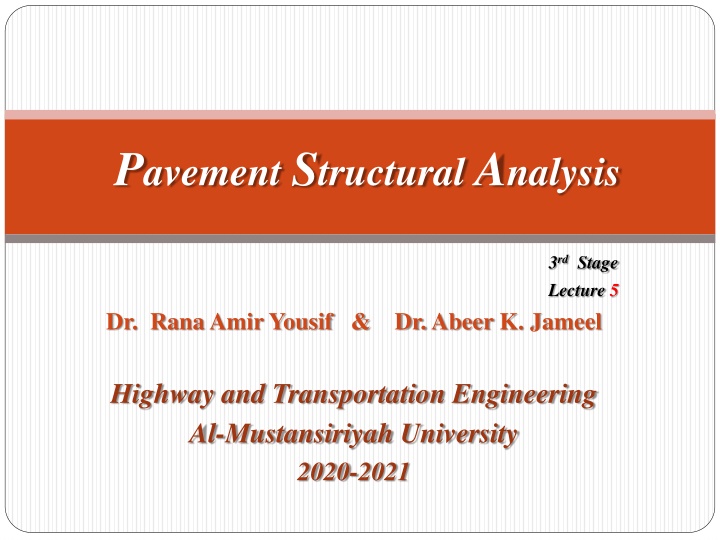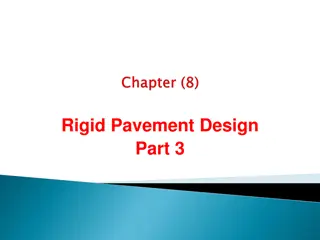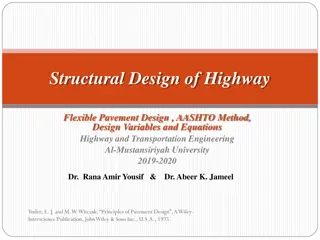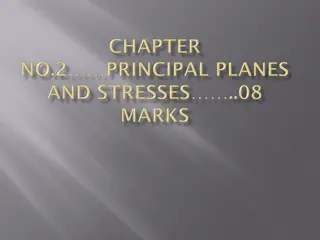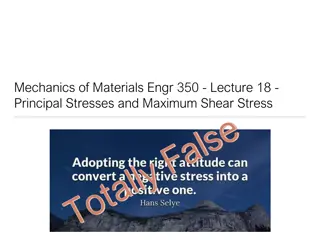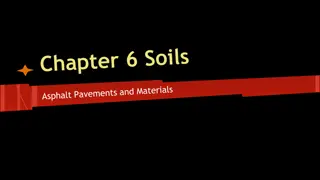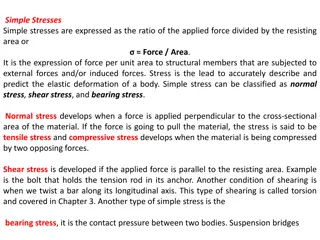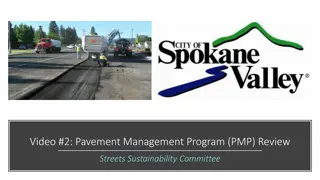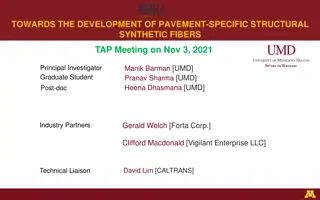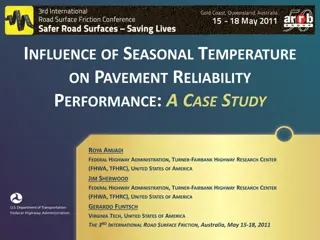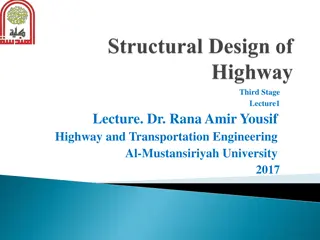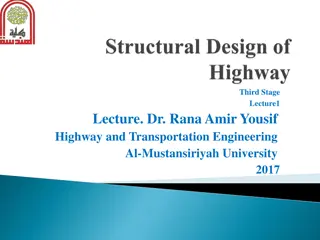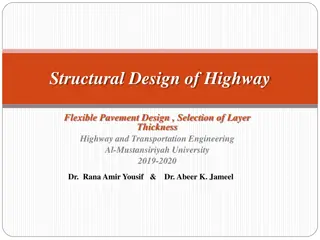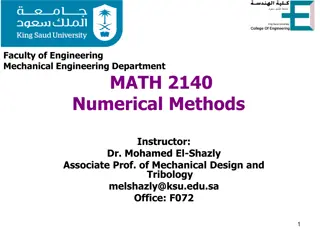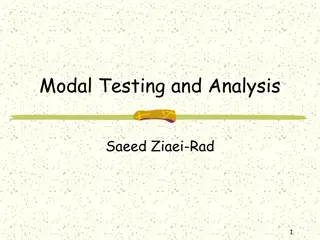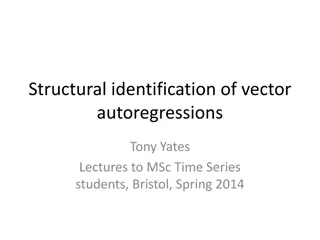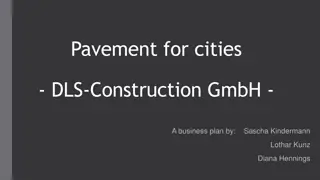Nonlinear Analysis of Pavement Structural Stresses and Deflections
"Explore the effect of nonlinearity in granular materials on vertical stresses and deflections in pavement structural analysis. Learn about iterative methods and stress invariants to understand pavement behavior under traffic loads. Discover the application of Boussinesq's solutions and Burmister's layered theory in pavement engineering."
Download Presentation

Please find below an Image/Link to download the presentation.
The content on the website is provided AS IS for your information and personal use only. It may not be sold, licensed, or shared on other websites without obtaining consent from the author.If you encounter any issues during the download, it is possible that the publisher has removed the file from their server.
You are allowed to download the files provided on this website for personal or commercial use, subject to the condition that they are used lawfully. All files are the property of their respective owners.
The content on the website is provided AS IS for your information and personal use only. It may not be sold, licensed, or shared on other websites without obtaining consent from the author.
E N D
Presentation Transcript
Pavement Structural Analysis 3rdStage Lecture 5 Dr. RanaAmir Yousif & Dr. Abeer K. Jameel Highway and Transportation Engineering Al-Mustansiriyah University 2020-2021
References: Nicholas J. Garber and Lester A. Hoel. Traffic and Highway Engineering , Fourth Edition. Yoder; E. J. and M. W. Witczak, Principles of Pavement Design , AWiley- Interscience Publication, John Wiley & Sons Inc., U.S.A., 1975. Yaug H. Huang, Pavement Analysis and Design , Prentic Hall Inc., U.S.A., 1993. AASHTO Guide for Design of Pavement Structures 1993 , AASHTO, American Association of State Highway and Transportation Officials, U.S.A., 1993. Oglesby Clarkson H., Highway Engineering , John Wiley & Sons Inc., U.S.A., 1975.
Stresses in Pavements 2.1.3 Nonlinear Mass Boussinesq's solutions are based on the assumption that the material that constitutes the half-space is linear elastic . It is well known that sub-grade soils are not elastic and undergo permanent deformation under stationary loads . However, under the repeated application of moving traffic loads, most of the deformations are recoverable and can be considered elastic . It is therefore possible to select a reasonable elastic modulus commensurate with the speed of moving loads . Linearity implies the applicability of the superposition principle, so the elastic constant must not vary with the state of stresses . In other words, the axial deformation of a linear elastic material under an axial stress should be independent of the confining pressure . This is evidently not true for soils, because their axial deformation depends strongly on the magnitude of confining pressures. Consequently, nonlinearity on Boussinesq's solution is of practical interest . the effect of
Iterative Method To show the effect of nonlinearity of granular materials on vertical stresses and deflections, Huang (1968a) divided the half-space into seven layers, as shown in Figure 2.11, and applied Burmister's layered theory to determine the stresses at the mid-height of each layer. Note that the lowest layer is a rigid base with a very large elastic modulus. After the stresses are obtained, the elastic modulus of each layer is determined from in which is the stress invariant, or the sum of three normal stresses ; E is the elastic modulus under the given stress invariant; E0 is the initial elastic modulus, or the modulus when the stress invariant is zero ; and is a soil constant indicating the increase in elastic modulus per unit increase in stress invariant .
Iterative Method Note that the stress invariant should include both the effects of the applied load and the geostatic stresses ; it can be expressed as Where: are the vertical, radial, and tangential stresses due to loading ; is the unit weight of soil ; z is the distance below ground surface at which the stress invariant is computed; and K0 is the coefficient of earth pressure at rest.
The problem can be solved by a method of successive approximations. First, an elastic modulus is assumed for each layer and the stresses are obtained from the layered theory . Given the stresses thus obtained, a new set of moduli is determined from Eq.2.11 and a new set of stresses is then computed . The process is repeated until the moduli between two consecutive iterations converge to a specified tolerance .
In applying the layered theory for nonlinear analysis, a question immediately arises : Which radial distance r should be used to determine the stresses and the moduli? Huang (1968a) showed that the vertical stresses are not affected significantly by whether the stresses at r = 0 or r = are used to determine the elastic modulus, but the vertical displacements are tremendously affected . He later used the finite-element method and found that the nonlinear behavior of soils has a large effect on vertical and radial displacements, an intermediate effect on radial and tangential stresses, and a very small effect on vertical and shear stresses (Huang ,1969a). Depending on the depth of the point in question, the vertical stresses based on nonlinear theory may be greater or smaller than those based on linear theory and, at a certain depth, both theories could yield the same stresses . This may explain why Boussinesq's solutions for vertical stress based on linear theory have been applied to soils with varying degrees of success, even though soils them selves are basically nonlinear .
Approximate Method One approximate method to analyze a nonlinear half-space is to divide it into a number of layers and determine the stresses at the midheight of each layer by Boussinesq's equations based on linear theory. From the stresses thus obtained, the elastic modulus E for each layer is determined from Eq.2.11. The deformation of each layer, which is the difference in deflection between the top and bottom of each layer based on the given E, can then be obtained . Starting from the rigid base, or a depth far from the surface where the vertical displacement can be assumed zero, the deformations are added to obtain the deflections at various depths . The assumption of Boussinesq's stress distribution was used by Vesic and Domaschuk (1964) to predict the shape of deflection basins on highway pavements, and satisfactory agreements were reported.
It should be noted that Eq . 2.11 is one of the many constitutive equations for sands. Uzan (1985), Pezo et al . (1992), and Pezo (1993) assumed that the modulus of granular materials depended not only on the stress invariant, , but also on the deviator stress, which is the difference between major and minor principal stresses . This concept has been used in the 2002 Design Guide, as presented in Appendix F . Other constitutive relationships for sands or clays can also be used, as discussed in Section 3 .1 .4 .
Example 2.4 : A circular load having radius 6 in . (152 mm) and contact pressure 80 psi (552 kPa) is applied on the surface of a sub-grade. The sub-grade soil is a sand with the relationship between the elastic modulus and the stress invariant shown in Figure 2.12a . The soil has Poisson ratio 0.3, the mass unit weight is 110 pcf (17.3 kN/m3 ), and the coefficient of earth pressure at rest is 0 .5 . The soil is divided into six layers, as shown in Figure 2.12b . Determine the vertical surface displacement at the axis of symmetry.
FIGURE 2.12 Example 2.4 (1 in . = 25 .4 mm, 1 psi = 6.9 kPa, 1 pcf = 157 .1 N/m 3 ) .
Solution: Given : At the mid-height of layer 1, z = 6 in . (152 mm) . From Eq.2.2, From Eq.2.3, From Eq.2.12,
Solution: Given : At the mid-height of layer 1, z = 6 in . (152 mm) . From Eq.2.11,with E0 =18,000 psi and = 0.0104 As shown in Figure 2.12a, From Eq.2.6, the deflection at top ,when z=0 And the deflection at bottom when z=12, Yoder; E. J. and M. W. Witczak, Principles of Pavement Design , A Wiley- Interscience Publication, John Wiley & Sons Inc., U.S.A., 1975.
Solution: The deformation of layer1 is 0.0283-0.0109 = 0.0174in. The deformations for other layers can be determined similarly, and the results are tabulated in Table 2 .1 . Yoder; E. J. and M. W. Witczak, Principles of Pavement Design , A Wiley- Interscience Publication, John Wiley & Sons Inc., U.S.A., 1975.
Solution: Yoder; E. J. and M. W. Witczak, Principles of Pavement Design , A Wiley- Interscience Publication, John Wiley & Sons Inc., U.S.A., 1975.
To compute the deformation of each layer, the product of w and E at each layer interface is first determined from Eq.2.6 . The difference in wE between the two interfaces divided by E gives the deformation of the layer. The surface deflection is the sum of all layer deformations and equals to 0.0325 in . (0.826 mm) . It is interesting to note that the stress invariant due to the applied load decreases with depth, while that due to geostatic stresses increases with depth . As a result, the elastic moduli for all layers, except layers 1 and 6, become nearly the same . Note also that more than 50% of the surface deflections are contributed by the deformation in the top 12 in. (305 mm) .
The same problem was solved by KENLAYER after the incorporation of Eq. 2.11 into the program . The differences in stress distribution between Boussinesq and Burmister theory and the resulting moduli are shown in Table 2.2 . It can be seen that the two solutions correspond well . The surface deflection based on layered theory. is 0 .0310 in . (0 .787 mm), which also agrees with the 0 .0325 in. (0.826 mm) from Boussinesq theory.
Pavement Structural Analysis
